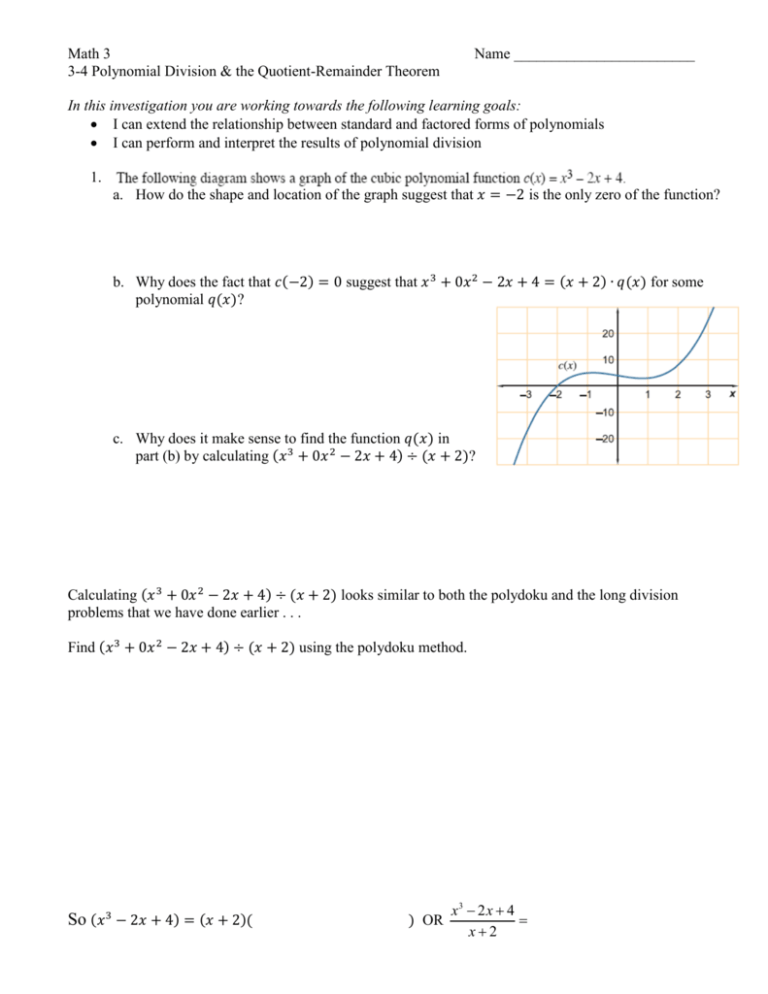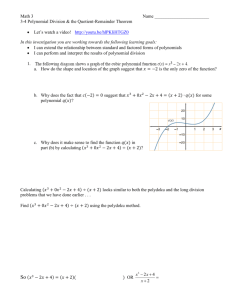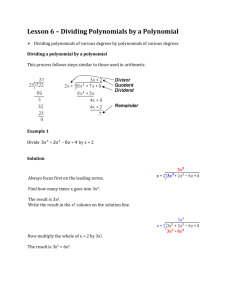3-4 Polynomial Division and Q
advertisement

Math 3 3-4 Polynomial Division & the Quotient-Remainder Theorem Name ________________________ In this investigation you are working towards the following learning goals: I can extend the relationship between standard and factored forms of polynomials I can perform and interpret the results of polynomial division 1. a. How do the shape and location of the graph suggest that 𝑥 = −2 is the only zero of the function? b. Why does the fact that 𝑐(−2) = 0 suggest that 𝑥 3 + 0𝑥 2 − 2𝑥 + 4 = (𝑥 + 2) ∙ 𝑞(𝑥) for some polynomial 𝑞(𝑥)? c. Why does it make sense to find the function 𝑞(𝑥) in part (b) by calculating (𝑥 3 + 0𝑥 2 − 2𝑥 + 4) ÷ (𝑥 + 2)? Calculating (𝑥 3 + 0𝑥 2 − 2𝑥 + 4) ÷ (𝑥 + 2) looks similar to both the polydoku and the long division problems that we have done earlier . . . Find (𝑥 3 + 0𝑥 2 − 2𝑥 + 4) ÷ (𝑥 + 2) using the polydoku method. So (𝑥 3 − 2𝑥 + 4) = (𝑥 + 2)( ) OR x3 2 x 4 x2 Example Find (𝑥 3 − 2𝑥 + 4) ÷ (𝑥 + 2) using long division So (𝑥 3 − 2𝑥 + 4) = (𝑥 + 2)( ) OR x3 2 x 4 x2 So right about now you are problem asking “Why is writing the function 𝑥 3 − 2𝑥 + 4 in the form (𝑥 + 2)( ) so important? Good question! We will answer that question eventually (in a later section), but for now we need to focus on writing polynomials in equivalent forms, given one real zero. So let’s practice! 2. a. s x x3 2 x 2 4 x 7 b. t x x4 2 x3 2 x2 17 x 42 SHOW ALL WORK BELOW: a.) Zero at x = _____ b.) Zero at x = _____ x3 2 x 2 4 x 7 x 4 2 x3 2 x 2 17 x 42 OR x3 2 x 2 4 x 7 OR x 4 2 x3 2 x 2 17 x 42 3. SHOW ALL WORK BELOW: a.) b.) x3 5 x 2 4 x 20 x3 2 x 2 4 x 7 OR x3 5 x 2 4 x 20 OR x3 2 x 2 4 x 7 4. Perform the following polynomial division a. 3x 3 17 x 2 10 x x 2 5 x b. 3x 5 6 x 4 2 x3 2 x 2 3x 1 x 3 x 2 1 PROBLEM 4 CONTINUED ON NEXT PAGE c. 5. 2x 5 6 x 4 4 x 3 12 x 2 3x 7 x 2 3x How is the division in problem (4) different from in problem (3)? Quotient-Remainder Theorem: If 𝑝(𝑥) is a polynomial and 𝑑(𝑥) is a nonzero polynomial, then there exist unique polynomials 𝑞(𝑥) and 𝑟(𝑥) such that for all numbers x, (1) 𝑝(𝑥) = 𝑞(𝑥) ∙ 𝑑(𝑥) + 𝑟(𝑥) (2) Either degree of 𝑟(𝑥) < degree of 𝑑(𝑥) Or 𝑟(𝑥) is the zero polynomial. The polynomial 𝑞(𝑥) is called the quotient and 𝑟(𝑥) is called the remainder for the division of 𝑝(𝑥) by 𝑑(𝑥). 6. In each part of problem (2), you chose a factor x k so that k was a zero of the original polynomial and found that all the remainders were zero. In problem (3), each polynomial division by a linear factor of x k produced a quotient and a remainder. Let’s explore the connection between the remainder of polynomial division, the zeroes of polynomial division, and evaluating polynomials. Take notes below. Let p x 3x3 2x2 9x 4 Let p x 2 x3 4 x2 11x 9 Is x 1 a factor of p x ? Is x 1 a factor of p x ? x 1 3x3 2x2 9x 4 x 1 2x3 4x2 11x 9 SUMMARY: Write a few sentences explaining long division. Explain the process, what the quotient means, what the remainder means, etc.







